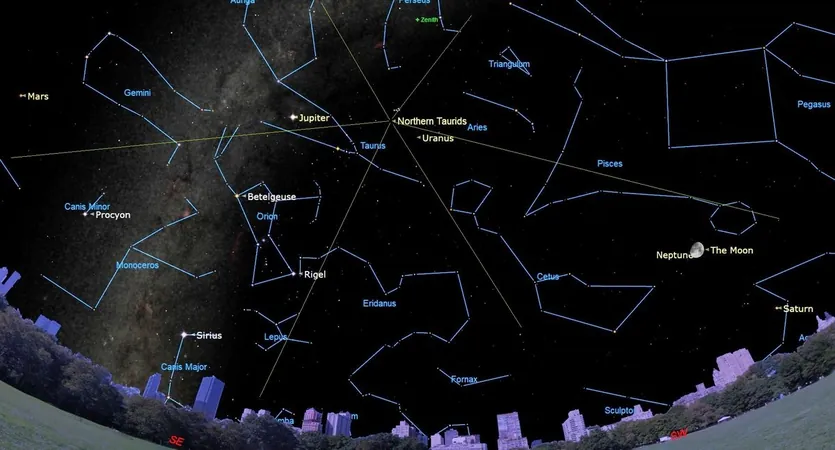
Witness the Spectacular Taurid Meteor Shower: A Celestial Show of Colorful Fireballs Tonight!
2024-11-11
Author: Jessica Wong
Get ready for an astronomical treat as the Taurid meteor shower peaks this week! If you find yourself outside during the late-night hours, don't miss the chance to catch a glimpse of these vibrant "shooting stars." This annual spectacle graces our skies from mid-October to mid-November, with the best viewing opportunity happening from November 5 to November 12.
During this peak period, stargazers can expect to see around 8 to 12 meteors per hour if they're under dark skies—perfect for a night of celestial wonder. What makes the Taurids unique is their radiant point in the constellation Taurus, which sits low on the eastern horizon shortly after sunset and climbs overhead around 1:30 AM. Unlike most meteor showers that peak after midnight, the Taurids can be observed all night long.
With the moon having been new on November 1 and gradually setting earlier each night, the conditions for meteor viewing couldn't be better. By the morning of November 12, the moon will only be visible until about 2:30 AM, allowing perfect dark skies for meteor spotting.
Why the Taurids Shine Brighter!
These meteors, often called "shooting stars," result from cosmic debris entering Earth's atmosphere and incinerating at high speeds. The Taurids are particularly special because they are known for their slower speeds—traveling at about 19 miles (30 km) per second—which allows for a more prolonged and visually stunning streak across the sky. You'll likely see vibrant colors—mostly yellow, but also orange, green, red, and blue—making the viewing experience even more enchanting. Excitingly, this shower is also known to produce spectacular "Halloween fireballs" that can occur at any time throughout the shower’s peak.
Interestingly, the Taurid stream contains larger remnants from the periodic comet Encke, which last passed near the Earth this October and is projected to return in February 2027. This stream's larger fragments result in occasional fireballs which captivate viewers with their brightness.
Double the Fun: Northern and Southern Taurids
Did you know that the Taurid meteor shower is divided into two components? The Northern and Southern Taurids provide an extended period of viewing excitement. The Southern Taurids peak in early November, while the Northern Taurids reach their climax a week later, around November 12. As these streams overlap for multiple weeks, viewers can expect to see meteors throughout the night sky, from southeastern Pisces to the lovely Pleiades star cluster.
According to astronomers Margaret Campbell-Brown and Peter Brown, the best time to spot the Southern Taurids is on November 5, followed by the Northern Taurids on November 12, both visible just south of the Pleiades.
So, if you're keen on witnessing a yellowish meteor lazily dashing across the sky, rest assured it’s a Taurid, a celestial fragment from Comet Encke!
Capture the Magic!
If you’d like to take your experience one step further, why not try photographing the meteors? There are guides available to help you capture those fleeting moments of brilliance. Plus, stay updated with night sky guides that tell you exactly when and where to look for the best starry delights.
Don't let this stunning astronomical event pass you by—grab a blanket, head outside, and immerse yourself in the cosmic dance happening overhead tonight!




 Brasil (PT)
Brasil (PT)
 Canada (EN)
Canada (EN)
 Chile (ES)
Chile (ES)
 España (ES)
España (ES)
 France (FR)
France (FR)
 Hong Kong (EN)
Hong Kong (EN)
 Italia (IT)
Italia (IT)
 日本 (JA)
日本 (JA)
 Magyarország (HU)
Magyarország (HU)
 Norge (NO)
Norge (NO)
 Polska (PL)
Polska (PL)
 Schweiz (DE)
Schweiz (DE)
 Singapore (EN)
Singapore (EN)
 Sverige (SV)
Sverige (SV)
 Suomi (FI)
Suomi (FI)
 Türkiye (TR)
Türkiye (TR)